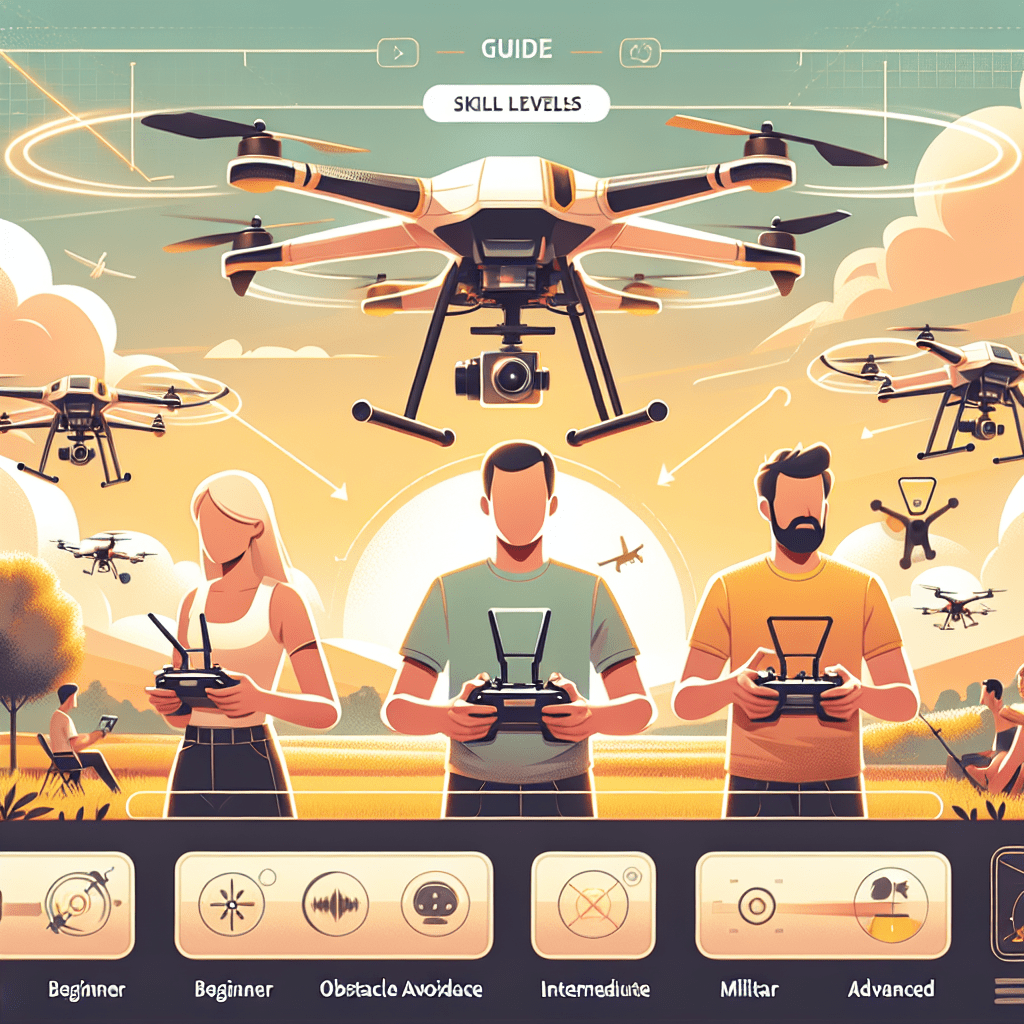Beginner Drones: The Best Models by Skill Level 2024
In This Article
- Start with a beginner drone to build confidence gradually.
- Evaluate skill level thoroughly before upgrading.
- Choose drones with safety features if new to flying.
- Always account for essential accessories in your budget.
- Use interactive tools to find your ideal drone match.
1. Understanding Your Skill Level
Evaluate Your Experience Before Buying
If you’re new to the world of flying machines, starting with Beginner Drones is essential. Determining your actual experience level is the foremost step before investing in any drone. Beginner Drones are specifically designed to offer simpler controls, increased flight stability, and automated safety features. These make them the ideal entry point for anyone just stepping into aerial photography or flight exploration.
Those who have already piloted budget toy drones or simple quadcopters may be ready to graduate to intermediate models that offer increased range, better cameras, and more manual control options. Advanced users—individuals using drones for professional video shoots, surveying, or commercial use—must demand high-performance machines with customisable flight settings and cinematic-grade capabilities.
It’s crucial to be honest about your comfort level with flying. Do you understand basic flight mechanics? Have you practised navigating in different wind conditions? Can you complete takeoffs and landings with confidence? Answering these questions will help define whether to start with Beginner Drones or explore more capable models.

2. Key Features to Consider at Each Level
What Makes a Drone Beginner, Intermediate, or Advanced?
Each drone classification offers a distinct set of features designed to match the capabilities of users at various stages. Beginner Drones, for example, usually include GPS stabilisation, one-button take-off and landing, and altitude hold functions. These assistive technologies dramatically shorten the learning curve and improve first-flight success rates.
Intermediate drones step up by offering manual flight modes, gimbal-stabilised cameras, brushless motors, and improved remote control ranges. These units are perfect for hobbyists keen to experiment with creative filming or flying in new environments.
At the advanced level, drones include obstacle avoidance sensors, comprehensive flight programming abilities, 4K or higher camera resolutions, and the ability to integrate with third-party apps for editing, surveying, or livestream broadcasting. While these features enhance creative freedom and capability, they also demand a higher baseline knowledge of drone mechanics and airspace regulation.
“Ease of use separates beginner drones from intermediate or professional UAVs. Start simple, scale when confident.”
3. Drones for First-Time Flyers
When entering the drone hobby, your first purchase should always offer low-cost entry with robust fail-safes. Models like the Ryze Tello or the Potensic A20 are ideal Beginner Drones. They come with built-in safety features such as auto-hovering and emergency stop to minimise damage during crashes. Most include 720p or basic 1080p cameras—sufficient for learning aerial framing without overwhelming you with technical configuration.
Many beginner-level units can also sync to smartphones, eliminating the complexity of a bulky controller. Added features like Headless Mode and Return-to-Home make navigation easier for new pilots. Learn more about Drone Buying & Ownership Guides See our curated Beginner Drone buying guide for more suggestions.
4. Intermediate Drones for Hobby Progression
Once you’ve mastered basic flying, intermediate drones open new creative avenues. Models such as the DJI Mini series or the Holy Stone HS720E strike a perfect balance between power and control. These drones tend to include 2-axis or 3-axis gimbals, far-enhanced photo and video quality, and range extensions of up to 2 kilometres in ideal conditions.
Intermediate participants often experiment with FPV (first-person view) flying or shoot social media-ready content straight from the sky. Transitioning from Beginner Drones to these models lets you embrace greater flexibility without confronting a steep technical learning curve.
5. Advanced Drones for Serious Aerial Work
For veteran pilots or professionals using UAVs in film, agriculture, real estate, or surveying, advanced drones are indispensable. These offer comprehensive flight customisation and payload options. Models like the DJI Mavic 3 Pro or the Autel EVO II Pro feature large image sensors, AI-assisted tracking, and triple-camera systems that deliver cinematic-quality results.
Advanced drones also typically include high-end safety features such as precision obstacle detection and redundancy systems (e.g., dual GPS or extra battery terminals) that protect your investment during mission-critical operations. At this level, full compliance with aviation laws and registration is mandatory, depending on your locale. 2024’s top beginner drone picks at Drone Nerds
6. Compare Top Drones for Each Tier
A structured comparison helps visualise progression clearly. Here’s how top models in each category measure up:
- Beginner Drones: Ryze Tello – Lightweight, basic camera, excellent stability, and under £100.
- Intermediate: DJI Mini 2 SE – 2.7K camera, 10km range, up to 30 minutes flight time.
- Advanced: DJI Air 3 – Dual-camera setup, obstacle sensing, 4K/60FPS video recording.
Each of these drones is best-in-class for its category. The transition should be natural as skills improve and your interest deepens. Read a related article Visit our side-by-side drone comparison chart for more specs and user reviews.
7. Interactive Quiz: Match to Your Drone
Not sure which drone fits your skill level? Our interactive quiz helps you identify the perfect match based on specific user profiles. Answer questions regarding your prior experience, planned use-cases, and tech inclinations, and we’ll generate a personal drone recommendation list tailored to your journey—from basic Beginner Drones to advanced quadcopters equipped for commercial use.
This tool also explains why certain features may or may not be necessary for you at this stage and recommends incremental upgrades so your journey evolves alongside your skills.
8. Common Mistakes When Buying Your First Drone
One of the major mistakes beginners make is purchasing a drone that’s too advanced. Expensive models may be enticing, but without sufficient flight control experience, you risk damaging complex hardware—or worse, violating local airspace regulations due to lack of understanding.
Another frequent issue involves overlooking the cost of accessories such as batteries, SD cards, and carry cases. Beginner Drones often have limited battery life, with flights lasting between 5 to 15 minutes. Buying additional batteries should always factor into your initial investment.
Lastly, avoid ignoring firmware updates and local drone laws. Whether you’re flying in your garden or a public park, always register where required and update your drone for optimal performance and flight safety.
9. Accessories You May Need
To get the most enjoyment and utility from Beginner Drones, certain accessories are essential. Extra propellers and guards are often omitted from cheaper packages but are vital for protecting your device during early flights. Carrying cases, spare batteries, and charging hubs ensure you’re never grounded when the terrain and weather align perfectly.
Additionally, consider buying a basic flight simulator or app-based training programme. These resources provide virtual practice environments, helping you build confidence and minimise crash risk before flying outdoors. For camera drones, SD cards with high transfer rates are crucial to storing high-quality video footage.
10. Summary and Next Steps
Choosing the correct drone based on your current experience—whether you’re entirely new to the game or looking to level up—ensures a far more rewarding, safer flight experience. Beginner Drones provide the cushion many individuals require to learn navigation basics, while intermediate and advanced options fuel expanding creativity and professional opportunities.
Our expert guide walks you through every level, helping you avoid decision paralysis and buyer’s remorse. Now that you understand your drone journey’s stages, you’re better equipped to make a lasting and satisfying purchase in 2024.
Final Thoughts on Beginner Drones in 2024
Beginner Drones remain the bedrock of drone-based hobbies and aerial content creation. Their accessible pricing, user-friendly designs, and feature reliability make them the best launchpad for educating new pilots and nurturing future experts. In 2024, the diversity of available models means there is truly a drone for every need and skill tier. As capabilities rise, so too must your attention to flight legality, ownership responsibilities, and gear investment.
Great guide on how-to-choose-the-best-drone-for-your-skill-level-in-2024-interactive – Community Feedback
What is the best drone for beginners in 2024?
In 2024, standout beginner drones include the DJI Avata 2, DJI Avata, and DJI Mini 4 Pro, all known for user-friendly controls, advanced safety features, and ease of use for new pilots.
What is the best mapping drone in 2024?
The DJI Air 2S is widely regarded as the top mapping drone in 2024, equipped with a robust 3750 mAh battery and a large 1-inch sensor ideal for surveying and mapping tasks.
How to choose the best drone for your needs?
Assess your experience, intended use (e.g., photography, mapping), desired features (such as GPS, obstacle avoidance), and budget. Matching these with your skill level ensures you get the best drone for your needs.

